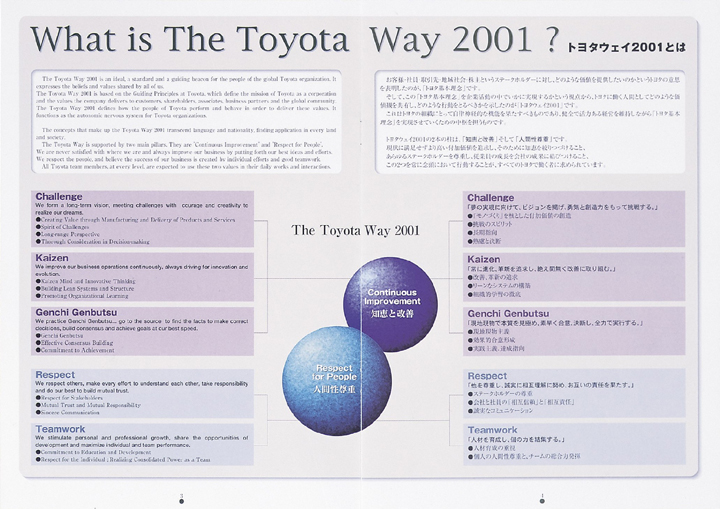Section 7. The Functions that Supported Globalization
Item 4. Human Resources Development
Compilation of the Toyota Way
Due to the rapid global expansion that began in the second half of the 1990s, the number of TMC employees on a consolidated basis exceeded 200,000 in fiscal 1999 (ended March 2000) and 300,000 in fiscal 2007 (ended March 2008). In comparison, the number of TMC employees on an unconsolidated basis was approximately 65,000 in fiscal 1999 (ended March 2000), as the workforce reduction resulting from the hiring freeze that followed the bursting of the economic bubble began to abate. With such a rapid increase in the number of employees outside Japan, the need to establish a globally common personnel management system became critical.
In particular, as TMC's human resources became more diversified, it was becoming essential to systematically develop overseas human resources that would share TMC's core management values and code of conduct, and to whom TMC could delegate management responsibilities. Therefore, in October 1998, TMC established the Toyota Way Compilation Project Secretariat inside the BR Global Human Resources Department and set out to compile the Toyota Way. The Toyota Way gathered together the management philosophy and values that had been passed on as implicit knowledge and made them available in an easy-to-understand systematic and visual manner.
For this project, the philosophies and values of predecessors and forbearers were extracted from the Five Main Principles of Toyoda and the Guiding Principles at Toyota and, following many rounds of consultation with TMC executives, were compiled as the Toyota Way 2001 in April 2001. This document explained the five key concepts of "Challenge", "Kaizen (continuous improvement)", "Genchi Genbutsu (go to the source to find the facts)", "Respect", and "Teamwork", under the two main principles of "Continuous Improvement" and "Respect for People", and was distributed in booklet form (including an English version) to all TMC affiliates inside and outside Japan.
President Fujio Cho, who directed the creation of the Toyota Way, stated at the beginning of the booklet, "The Toyota Way defines the company's fundamental DNA, which summarizes the unique and outstanding elements of our company culture and success for all of us who work at Toyota. I urge all of you to maintain an attitude of continually asking yourself 'Is this a Toyota Way?'" Positioning the Toyota Way as something that was not static and must be evolved and developed, President Cho also added "2001" to the official name of the booklet and encouraged TMC employees to actively discuss the future shape of Toyota.
The Toyota Way was broken down according to function and was also implemented at the individual divisional level. For example, for the sales function, a booklet called "The Toyota Way in Sales and Marketing" was created n October 2001 with the goal of sharing, spreading, and propagating Toyota's sales and marketing philosophy to sales and marketing personnel throughout the world. Then, in 2002, TMC established its Global Knowledge Center, a dedicated sales and marketing training organization in California, United States, which began activities as the global base for spreading the Toyota Way in Sales and Marketing.
Then, in October 2002, the Accounting Group issued the The Toyota Way in Accounting & Finance. This booklet clearly expressed the mission of the group in setting direction, as well as the role it plays in promoting actions to ensure profitability and in assessing and disclosing financial conditions. As the basis for executing tasks, the booklet has been actively utilized for training new employees as well as orienting mid-career recruits and internally transferred employees.
Beside those described above, various other major functional groups have created their own functionally oriented Toyota Way, for example the Toyota Way in Personnel and Labor Relations, the Toyota Way in Purchasing, and the Toyota Way in R & D.


